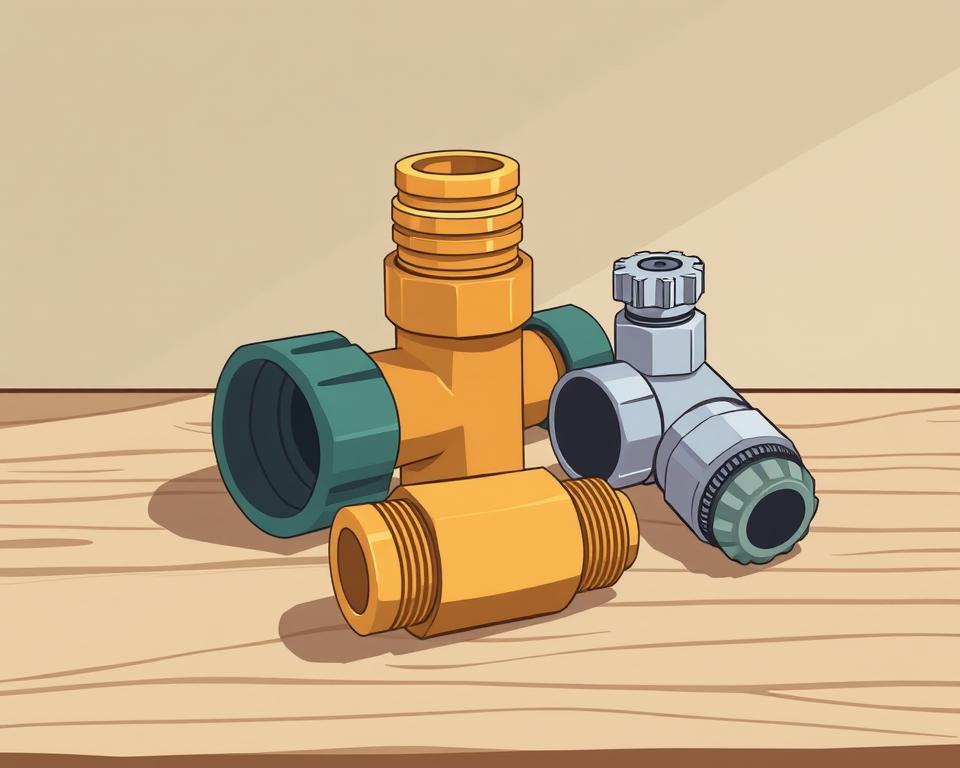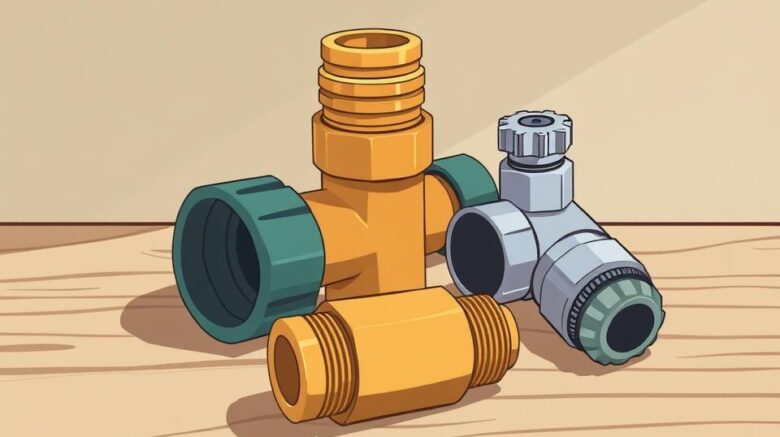Essential Yard Accessories: Standard Garden Hose Fittings
Ever wondered why your watering system leaks or underperforms? Tiny what size is a standard garden hose fitting connectors—your standard garden hose fittings—often cause leaks and poor performance. They preserve flow, guard against leaks, and support a healthy yard.
Installation Parts Supply, a trusted provider of plumbing solutions, highlights that 67% of hose failures stem from poor-quality or mismatched connectors. The right fittings make all the difference, whether you’re setting up a simple sprinkler or a complex irrigation system.
With ANSI ¾”-11.5 NH threads, most fittings fit most hoses. Refer to this guide for choosing robust fittings, testing pressure limits, and avoiding errors. Boost your hose setup without second thoughts!
Key Takeaways
- Proper fittings prevent leaks and improve water efficiency.
- The 3/4″ thread size is the industry standard (ANSI ¾”-11.5 NH).
- Installation Parts Supply offers reliable plumbing solutions.
- Longevity depends on material quality and pressure tolerance.
- Two-thirds of hose failures start at faulty connections.

The Importance of Picking Proper Garden Hose Fittings
Leaky fittings can dump far more water than you’d expect. Inferior connectors cause 40% of irrigation water waste. That’s like leaving the faucet running while you’re not even using it!
Mismatched parts can drop pressure by up to 20%. You may find your sprinklers struggle to cover the lawn. Limit pressure-washer hoses to 50 ft to avoid flow loss.
Don’t overlook safety issues. Burst connections at high PSI can injure users or damage equipment. Installation Parts Supply’s *pressure-rated solutions* prevent these hazards with reinforced designs.
You need parts that last. Corrosion-resistant materials last years longer, especially in salty or humid climates. Fast-disconnects can freeze and leak—inspect them seasonally.
One homeowner upgraded their setup and saw a 35% boost in sprinkler efficiency. Proper fittings cut waste, work faster, and lower bills—no guesswork.
Understanding Standard Garden Hose Fittings
What makes some hose connections last for years while others fail in months? The answer lies in their components—ferrules, washers, and threaded ends. Every piece helps stop leaks and keep flow steady.
Grooved ferrules clamp the hose and prevent pull-offs. Smooth ferrules excel under pressure. Barbed ferrules secure hoses but risk flow restriction if crooked.
Washers are the unsung heroes. Most drips trace back to a bad washer. Make sure the washer is seated properly to stop leaks.
Thread engagement depth matters too. Fully engage the threads to avoid leaks. Even slight gaps let water escape. Single-body couplings hold up better under tough conditions than multi-part ones.
Installation Parts Supply’s patented anti-kink collar adds durability. It prevents bends that weaken the connection. Rotate O-ring inspections every three months to preserve sealing.
A quality fitting outperforms and outlasts. Select fittings by size and type to dodge errors.
Garden Hose Fitting Varieties
Stumped by different hose fitting styles? Let’s clarify the choices. Different fittings fill different needs—from speed to pressure control.
Quick-connect fittings let you swap accessories in seconds. Brass versions withstand higher PSI, while plastic works for light-duty tasks. Frost-resistant valves stand up to subzero conditions.
Swivel connectors let your hose pivot 270° to avoid kinks. Y-connectors let you run two hoses from one spigot. Great for washing cars while watering plants.
Pressure-regulating adapters protect sprinklers from surges. They even out flow under varying supply pressures. Refer to the table for cost vs. performance:
| Type | Material | Cost | Flow Rate (GPM) |
|---|---|---|---|
| Quick-Connect | Plastic | $1.50 | 4.2 |
| Quick-Connect | Brass | $8.00 | 5.1 |
| Y-Splitter | Aluminum | $6.50 | 3.8 (per outlet) |
Camlock couplers give tight seals in demanding applications. Stainless builds stand up to harsh chemicals and fertilizers. Most home systems call for ¾” ANSI threads.
Keep spare O-rings on hand for each fitting. A bad washer can cut PSI by 20% without obvious leaks.
Brass vs. Plastic vs. Aluminum
Not all connectors are created equal—material choice impacts durability and safety. Brass boasts a 500 PSI capacity; plastic about 150 PSI. Use lead-free brass for potable water to comply with Prop 65.
Aluminum outlasts plastic in sun exposure. Brass and aluminum resist temperatures that break plastic. Their brass-aluminum combo fittings blend strength and lightness.
Best uses for plastic fittings Light-duty drip and short-run applications. Refer to the table for price and PSI specs:
| Type | Material | Cost | Max PSI |
|---|---|---|---|
| Coupler | Plastic | $4 | 150 |
| Coupler | Brass | $12 | 500 |
| Hybrid | Brass-Aluminum | $9 | 400 |
Select materials based on weather and pressure requirements. You’ll replace plastic three times before a brass lasts out.
Hose Diameter Guide
Size impacts everything from water pressure to coverage area. 3/4″ hoses flow about 5 GPM, ideal for sprinklers. 5/8″ hoses give about 3 GPM, perfect for drip or light spray.
Longer hoses lose pressure fast. You’ll lose about 1 PSI per foot. Pressure washers need 50-foot maximums to maintain strong flow. Use their adapters to join different diameters leak-free.
Sprinkler reach by hose length:
- Ideal for pots and patios.
- 50 ft: Covers medium lawns (up to 1,500 sq ft).
- Needs more PSI to cover large areas.
Farms and big landscapes favor 1″ hoses. They supply greater flow for large areas. Refer to the table below:
| Diameter | Flow Rate (GPM) | Best For |
|---|---|---|
| ⅝ inch | 3 | Drip irrigation, small gardens |
| ¾ inch | 5 | Sprinklers, car washing |
| 1 inch | 7+ | Agriculture, large properties |
Assess your watering needs first. 3/4″ diameter is standard—just mind the hose length. Have adapters ready for quick tool changes.
Fitting Compatibility & PSI Ratings
What makes fittings burst under pressure surges? It hinges on the pressure thresholds. A 150 PSI fitting works under steady flow but may fail at 300+ PSI surges.
Burst rating shows ultimate strength. 300 PSI rating covers only surge events. Installation Parts Supply’s commercial-grade options handle these spikes, ideal for farms or pressure washers.
Heat in the sun boosts pressure. Every 10°F rise adds 5–10 PSI in a closed hose. Always leave slack in hoses to absorb expansion.
Pressure Ratings at a Glance
| Rating | Best For | Burst Strength |
|---|---|---|
| 150 PSI | Residential sprinklers | 450 PSI |
| 300 PSI | Irrigation systems | 900 PSI |
| 600 PSI | Industrial use | 1,800 PSI |
Thread mismatches cause 30% of leaks. Adapters must meet your PSI requirements. One farm’s switch to 300 PSI brass fittings reduced leaks by 40%.
Old vs. New Fittings? Checklist
- Match thread types (e.g., ANSI ¾”-11.5 NH).
- Check O-rings for damage before reuse.
- Test pressure tolerance of older parts.
- Replace corroded or dented connectors.
Hose type and attachments determine pressure specs. Proper prep avoids expensive leaks.
Installation & Care Tips
Minor upkeep keeps your fittings tight. Perform annual checks for wear, rust, and looseness. Re-tighten wobbly fittings promptly.
Leak detection is straightforward. Connect, pressurize, and scan for leaking spots. Check every connection point. Use their gauge to find invisible leaks.
Seasonal winterizing stops burst pipes. Empty hoses and stow inside. Slip on frost-proof covers. This prevents bursts that can ruin your *hose needs*.
You’ll need:
- Adjustable wrenches for secure tightening
- Thread seal tape to stop slow leaks
- Spare washers and a guide sheet
Replace washers every 6 months. Match washer size exactly—30% of drips stem from wrong seals. Stock replacements for speedy repairs.
Store hoses out of UV. UV exposure shortens hose life. A hanging rack or reel keeps them tangle-free and ready for action.
Can’t stop a drip? Do this:
- Brush threads clean of grit
- Apply plumber’s grease to stiff O-rings
- Replace damaged washers right away
Conclusion: Nail the Right Hose Fittings
Get the proper fittings to transform your hose setup. Brass or aluminum? Quick-connect or swivel? Match materials and types to your needs for leak-free performance.
Investing in good fittings is worth it. One brass connector could replace multiple plastics over time. Their warranty support adds confidence to your purchase.
Keep this guide handy:
- Verify PSI ratings before purchase
- Examine O-rings seasonally
- Winterize and store inside
Watch for upcoming fittings that detect drips. Until smart parts arrive, follow expert advice to get job done. Your garden hose rig deserves superior connectors!
